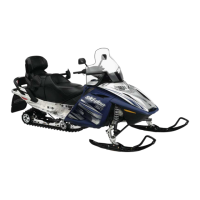Section052–TEC ENGINE MANAGEMENT
Subsection 01 (OVERVIEW)
When a fault occurs, it sends visual messages
through the referring LED and/or audible signals
through a buzzer to inform you of a particular con-
dition. Refer to the DIAGNOSTIC PROCEDURES
section for the referring LED and the buzzer coded
signals chart.
LIMP HOME MODES
Besides the signals as seen above, the ECM may
automatically set default parameters to the engine
management to ensure the adequate operation of
the vehicle if a component of the fuel injection
system is not operating properly.
NOTE: Sensor failures will not lead to a limp home
mode, warning will follow by the check engine
LED and in some cases the buzzer.
When minor fault occurs, the fault and mes-
sage/buzzer will disappear automatically, when
the condition disappears.
Depending on the severity of the malfunction, the
vehicle speed may be reduced and not allowed to
reach its usual top speed.
The engine RPM may be limited if some critical
components fail. In this case, releasing throttle
and letting the engine returning to idle speed may
allow normal operation to come back. If it does
not work, try removing and reinstalling the tether
cord cap on DESS post.
These performance-reduced modes allow the
rider to go back home which would not be pos-
sible without this advanced system. Refer to
the DIAGNOSTIC PROCEDURES for a complete
chart.
If a fault occurs and involves a limp home mode
operation, the engine management system will re-
duce engine RPM gradually to the proper level.
DIAGNOSTIC MODE
The malfunctions are recorded in the memory
of the ECM. The memory of the ECM can be
checked using the VCK (Vehicle Communication
Kit) (P/N 529 035 981) to see the fault codes. Re-
fer to the DIAGNOSTIC PROCEDURES section.
The ECM and the VCK are able to communicate
through a connector on the vehicle. The B.U.D.S.
software, version G2.10, P2.10 or up must be
used for this system.
CHARGING SYSTEM
The ignition system consists of different sub-sys-
tems where some are interrelated.
Unregulated AC current is produced by the mag-
neto. AC current is rectified and regulated be-
tween 13.4 and 15 volts for the vehicle electrical
system.
Vehicle 12-volt battery supplies the ECM with DC
current.
Refer to MAGNETO SYSTEM.
The following type of ignition system is used:
– Digital Inductive System.
MAGNETO SYSTEM
The magneto is the primary source of electrical
energy. It transforms magnetic field into electric
current (AC).
The magneto has a 3 phases, delta wound stator
on 18 poles. Capacity is 480 watts.
DOUBLE IGNITION COIL
Double ignition coil has two separate windings,
one for each spark plug.
Ignition coil induces voltage to a high level in the
secondary windings to produce a spark at the
spark plug.
Two separate windings receive input from the
ECM. Each winding provides high voltage to its
corresponding spark plug.
This ignition system allows spark plugs to spark
independently.
CAUTION: Do not interchange spark plug ca-
bles. Match reference (PTO or MAG printed
on high tension cable yellow tag) with corre-
sponding cylinder spark plug.
Double ignition coil is located underneath air si-
lencer.
mmr2004-Rev 171

